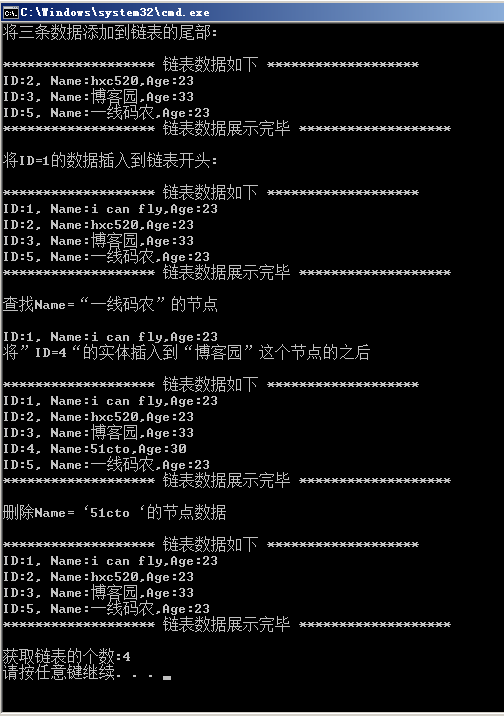一:线性表的简单回顾
上一篇跟大家聊过“线性表"顺序存储,通过实验,大家也知道,如果我每次向顺序表的头部插入元素,都会引起痉挛,效率比较低下,第二点我们用顺序存储时,容易受到长度的限制,反之就会造成空间资源的浪费。
二:链表
对于顺序表存在的若干问题,链表都给出了相应的解决方案。
1. 概念:其实链表的“每个节点”都包含一个”数据域“和”指针域“。
”数据域“中包含当前的数据。
”指针域“中包含下一个节点的指针。
”头指针”也就是head,指向头结点数据。
“末节点“作为单向链表,因为是最后一个节点,通常设置指针域为null。

代码段如下:
/// <summary>
/// 节点的指针域
/// </summary>
public Node<T> next;
}
#endregion
2.常用操作:
链表的常用操作一般有:
①添加节点到链接尾,②添加节点到链表头,③插入节点。
④删除节点,⑤按关键字查找节点,⑥取链表长度。
<1> 添加节点到链接尾:
前面已经说过,链表是采用指针来指向下一个元素,所以说要想找到链表最后一个节点,必须从头指针开始一步一步向后找,少不了一个for循环,所以时间复杂度为O(N)。
代码段如下:
node.data = data;
node.next = null;
///说明是一个空链表
if (head == null)
{
head = node;
return head;
}
//获取当前链表的最后一个节点
ChainListGetLast(head).next = node;
return head;
}
#endregion
#region 得到当前链表的最后一个节点
/// <summary>
/// 得到当前链表的最后一个节点
/// </summary>
/// <typeparam name="T"></typeparam>
/// <param name="head"></param>
/// <returns></returns>
public Node<T> ChainListGetLast<T>(Node<T> head)
{
if (head.next == null)
return head;
return ChainListGetLast(head.next);
}
#endregion
<2> 添加节点到链表头:
大家现在都知道,链表是采用指针指向的,要想将元素插入链表头,其实还是很简单的,
思想就是:① 将head的next指针给新增节点的next。②将整个新增节点给head的next。
所以可以看出,此种添加的时间复杂度为O(1)。
效果图:

代码段如下:
node.data = data;
node.next = head;
head = node;
return head;
}
#endregion
<3> 插入节点:
其实这个思想跟插入到”首节点“是一个模式,不过多了一步就是要找到当前节点的操作。然后找到
这个节点的花费是O(N)。上图上代码,大家一看就明白。
效果图:

代码段:
if (where(head.data).CompareTo(key) == 0)
{
Node<T> node = new Node<T>();
node.data = data;
node.next = head.next;
head.next = node;
}
ChainListInsert(head.next, key, where, data);
return head;
}
#endregion
<4> 删除节点:
这个也比较简单,不解释,图跟代码更具有说服力,口头表达反而让人一头雾水。
当然时间复杂度就为O(N),N是来自于查找到要删除的节点。
效果图:

代码段:
//这是针对只有一个节点的解决方案
if (where(head.data).CompareTo(key) == 0)
{
if (head.next != null)
head = head.next;
else
return head = null;
}
else
{
//判断一下此节点是否是要删除的节点的前一节点
while (head.next != null && where(head.next.data).CompareTo(key) == 0)
{
//将删除节点的next域指向前一节点
head.next = head.next.next;
}
}
ChainListDelete(head.next, key, where);
return head;
}
#endregion
<5> 按关键字查找节点:
这个思想已经包含到“插入节点”和“删除节点”的具体运用中的,其时间复杂度为O(N)。
代码段:
if (where(head.data).CompareTo(key) == 0)
return head;
return ChainListFindByKey<T, W>(head.next, key, where);
}
#endregion
<6> 取链表长度:
在单链表的操作中,取链表长度还是比较纠结的,因为他不像顺序表那样是在内存中连续存储的,
因此我们就纠结的遍历一下链表的总长度。时间复杂度为O(N)。
代码段:
while (head != null)
{
++count;
head = head.next;
}
return count;
}
#endregion
好了,最后上一下总的运行代码:
namespace ChainList
{
class Program
{
static void Main(string[] args)
{
ChainList chainList = new ChainList();
Node<Student> node = null;
Console.WriteLine("将三条数据添加到链表的尾部:/n");
//将数据添加到链表的尾部
node = chainList.ChainListAddEnd(node, new Student() { ID = 2, Name = "hxc520", Age = 23 });
node = chainList.ChainListAddEnd(node, new Student() { ID = 3, Name = "博客园", Age = 33 });
node = chainList.ChainListAddEnd(node, new Student() { ID = 5, Name = "一线码农", Age = 23 });
Dispaly(node);
Console.WriteLine("将ID=1的数据插入到链表开头:/n");
//将ID=1的数据插入到链表开头
node = chainList.ChainListAddFirst(node, new Student() { ID = 1, Name = "i can fly", Age = 23 });
Dispaly(node);
Console.WriteLine("查找Name=“一线码农”的节点/n");
//查找Name=“一线码农”的节点
var result = chainList.ChainListFindByKey(node, "一线码农", i => i.Name);
DisplaySingle(node);
Console.WriteLine("将”ID=4“的实体插入到“博客园”这个节点的之后/n");
//将”ID=4“的实体插入到"博客园"这个节点的之后
node = chainList.ChainListInsert(node, "博客园", i => i.Name, new Student() { ID = 4, Name = "51cto", Age = 30 });
Dispaly(node);
Console.WriteLine("删除Name=‘51cto‘的节点数据/n");
//删除Name=‘51cto‘的节点数据
node = chainList.ChainListDelete(node, "51cto", i => i.Name);
Dispaly(node);
Console.WriteLine("获取链表的个数:" + chainList.ChanListLength(node));
}
//输出数据
public static void Dispaly(Node<Student> head)
{
Console.WriteLine("******************* 链表数据如下 *******************");
var tempNode = head;
while (tempNode != null)
{
Console.WriteLine("ID:" + tempNode.data.ID + ", Name:" + tempNode.data.Name + ",Age:" + tempNode.data.Age);
tempNode = tempNode.next;
}
Console.WriteLine("******************* 链表数据展示完毕 *******************/n");
}
//展示当前节点数据
public static void DisplaySingle(Node<Student> head)
{
if (head != null)
Console.WriteLine("ID:" + head.data.ID + ", Name:" + head.data.Name + ",Age:" + head.data.Age);
else
Console.WriteLine("未查找到数据!");
}
}
#region 学生数据实体
/// <summary>
/// 学生数据实体
/// </summary>
public class Student
{
public int ID { get; set; }
public string Name { get; set; }
public int Age { get; set; }
}
#endregion
#region 链表节点的数据结构
/// <summary>
/// 链表节点的数据结构
/// </summary>
public class Node<T>
{
/// <summary>
/// 节点的数据域
/// </summary>
public T data;
/// <summary>
/// 节点的指针域
/// </summary>
public Node<T> next;
}
#endregion
#region 链表的相关操作
/// <summary>
/// 链表的相关操作
/// </summary>
public class ChainList
{
#region 将节点添加到链表的末尾
/// <summary>
/// 将节点添加到链表的末尾
/// </summary>
/// <typeparam name="T"></typeparam>
/// <param name="head"></param>
/// <param name="data"></param>
/// <returns></returns>
public Node<T> ChainListAddEnd<T>(Node<T> head, T data)
{
Node<T> node = new Node<T>();
node.data = data;
node.next = null;
///说明是一个空链表
if (head == null)
{
head = node;
return head;
}
//获取当前链表的最后一个节点
ChainListGetLast(head).next = node;
return head;
}
#endregion
#region 将节点添加到链表的开头
/// <summary>
/// 将节点添加到链表的开头
/// </summary>
/// <typeparam name="T"></typeparam>
/// <param name="chainList"></param>
/// <param name="data"></param>
/// <returns></returns>
public Node<T> ChainListAddFirst<T>(Node<T> head, T data)
{
Node<T> node = new Node<T>();
node.data = data;
node.next = head;
head = node;
return head;
}
#endregion
#region 将节点插入到指定位置
/// <summary>
/// 将节点插入到指定位置
/// </summary>
/// <typeparam name="T"></typeparam>
/// <param name="head"></param>
/// <param name="currentNode"></param>
/// <param name="data"></param>
/// <returns></returns>
public Node<T> ChainListInsert<T, W>(Node<T> head, string key, Func<T, W> where, T data) where W : IComparable
{
if (head == null)
return null;
if (where(head.data).CompareTo(key) == 0)
{
Node<T> node = new Node<T>();
node.data = data;
node.next = head.next;
head.next = node;
}
ChainListInsert(head.next, key, where, data);
return head;
}
#endregion
#region 将指定关键字的节点删除
/// <summary>
/// 将指定关键字的节点删除
/// </summary>
/// <typeparam name="T"></typeparam>
/// <typeparam name="W"></typeparam>
/// <param name="head"></param>
/// <param name="key"></param>
/// <param name="where"></param>
/// <param name="data"></param>
/// <returns></returns>
public Node<T> ChainListDelete<T, W>(Node<T> head, string key, Func<T, W> where) where W : IComparable
{
if (head == null)
return null;
//这是针对只有一个节点的解决方案
if (where(head.data).CompareTo(key) == 0)
{
if (head.next != null)
head = head.next;
else
return head = null;
}
else
{
//判断一下此节点是否是要删除的节点的前一节点
if (head.next != null && where(head.next.data).CompareTo(key) == 0)
{
//将删除节点的next域指向前一节点
head.next = head.next.next;
}
}
ChainListDelete(head.next, key, where);
return head;
}
#endregion
#region 通过关键字查找指定的节点
/// <summary>
/// 通过关键字查找指定的节点
/// </summary>
/// <typeparam name="T"></typeparam>
/// <typeparam name="W"></typeparam>
/// <param name="head"></param>
/// <param name="key"></param>
/// <param name="where"></param>
/// <returns></returns>
public Node<T> ChainListFindByKey<T, W>(Node<T> head, string key, Func<T, W> where) where W : IComparable
{
if (head == null)
return null;
if (where(head.data).CompareTo(key) == 0)
return head;
return ChainListFindByKey<T, W>(head.next, key, where);
}
#endregion
#region 获取链表的长度
/// <summary>
///// 获取链表的长度
/// </summary>
/// <typeparam name="T"></typeparam>
/// <param name="head"></param>
/// <returns></returns>
public int ChanListLength<T>(Node<T> head)
{
int count = 0;
while (head != null)
{
++count;
head = head.next;
}
return count;
}
#endregion
#region 得到当前链表的最后一个节点
/// <summary>
/// 得到当前链表的最后一个节点
/// </summary>
/// <typeparam name="T"></typeparam>
/// <param name="head"></param>
/// <returns></returns>
public Node<T> ChainListGetLast<T>(Node<T> head)
{
if (head.next == null)
return head;
return ChainListGetLast(head.next);
}
#endregion
}
#endregion
}
运行结果:

当然,单链表操作中有很多是O(N)的操作,这给我们带来了尴尬的局面,所以就有了很多的优化方案,比如:双向链表,循环链表。静态链表等等,这些希望大家在懂得单链表的情况下待深一步的研究。
新闻热点
疑难解答